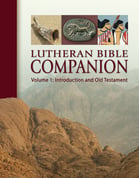Jump to:
Scribes for the Hebrew Bible described the Books of Isaiah, Jeremiah, and Ezekiel as the Latter Prophets (or simply “the Prophets”) and placed Lamentations and Daniel among their third category of Old Testament books, the Writings. They collected the Minor Prophets into the Book of the Twelve, which was similar in length to the longer Prophetic Books. As a result, the Hebrew canon counted four scrolls of the Latter Prophets, matching the number of scrolls for four Former Prophets. Thus, with the exception of Daniel, the Hebrew Latter Prophets correspond to what are usually simply referred to as the “Prophets” or prophetical books in English Bibles.
Isaiah
Overview of Isaiah
Isaiah is such a remarkable figure that one hardly knows where to begin. Both in variety and forcefulness he excels, whether one measures from literary or from theological standpoints. Only a few of the early critics ever seriously disputed that evaluation, either because Isaiah allegedly was not “original” enough for their developmental scheme or because his social action accent was less prominent than in some other prophets. For tradition and conservatism, of course, Isaiah towers especially because of his prominent messianic pronouncements.
Isaiah lived through, witnessed, and commented on one of the major turning points in Israel’s history—from the halcyon days of empire and independence under Uzziah through the fall of Samaria and the semi-escape of Judah only by accepting colonial status under the relentless pressure of the Assyrian colossus.
Purpose of Isaiah
Isaiah wrote to warn the people of Judah to repent so that they might escape God’s judgment, poured out through the Assyrians. However, the range of his prophecies of judgment spread in all directions to include virtually all nations known to ancient Israel and, indeed, all people throughout the world (chapters 13–24). The universal scope of judgment in Isaiah’s prophecies is complemented with the good news of Zion’s redemption, which also becomes the means of salvation for all people (chapters 2, 25).
Jeremiah
Overview of Jeremiah
Along Israel’s central ridge, about three miles northeast of Jerusalem, Jeremiah’s priestly ancestors settled in the region of the tribe of Benjamin where they looked out over the Jordan Valley and upward to Jerusalem. In ca. 970 BC, Jeremiah’s hometown of Anathoth become a city of exile for Abiathar, the chief priest who did not support Solomon’s accession as king after David (1 Kings 2:26). Jeremiah may have descended from this exiled priest but was at least associated with his descendants. The prophet was, therefore, born to controversy, which played so great a role in his ministry at Jerusalem during the last days before the Babylonians overran the city, plundered Solomon’s temple, and destroyed it.
Among the significant events of which Jeremiah was a contemporary, we may mention these: the death of the great Assyrian king Ashurbanipal; the subsequent swift decline and fall of Nineveh (612 BC) and of the entire Assyrian Empire; the battle of Megiddo (609 BC) in which Josiah lost his life; Nebuchadnezzar’s subsequent defeat of Egypt at the battle of Carchemish (605 BC); and the rapid change of imperialist occupiers of Judah, from Assyria to Egypt to Babylonia and two or three deportations from Jerusalem, the last one accompanying its destruction. Jeremiah is, indeed, the prophet who witnessed the decline and fall of the Davidic kings.
Purpose of Jeremiah
The Lord appointed Jeremiah “a prophet to the nations” (1:5) to declare their overthrow (1:10). Like his contemporary, Ezekiel, Jeremiah warned those still in Jerusalem that there was no future for them as an independent kingdom. But unlike Ezekiel, Jeremiah suffered significant persecution since the people of Jerusalem rejected his message and King Jehoiakim even burned a scroll of his prophecies. Jeremiah preached God’s judgment to deaf ears, and his oracles express to the Lord his frustrations.
Lamentations
Overview of Lamentations
There are numerous and striking similarities between some of the laments in the Book of Jeremiah and those in Lamentations (e.g., the phrase “daughter of” occurs about 20 times in each book; and “eyes flowing with tears” in Lamentations 1:16; 2:11 and Jeremiah 9:1, 18). The calamities lamented are attributed to the same causes in both books (national sin, faithless priests and prophets, the perfidy of allies in whom vain hope had been placed, etc.). Furthermore, despite formal differences among the five poems, there is no doubt that the same mood pervades all of them. As a result, tradition uniformly attributed the book to Jeremiah.
Purpose of Lamentations
The Book of Lamentations mourns the destruction of Jerusalem and its
people while expressing hope and prayers that the Lord will restore Zion.
The poems may have assisted the survivors in worship, directed toward
repentance and the future.
Ezekiel
Overview of Ezekiel
Groves of date palms cast shadows over dark-green, mid-summer fields that line the low-lying waterways between Erech and Babylon. On July 31, 593 BC, the exiled priest Ezekiel became a prophet as the Lord revealed to him a startling vision of His glory and inspired His servant to write.
In exile, the prophet lived “in the land of the Chaldeans by the Chebar canal” (1:3). Southern Mesopotamia was the homeland along one of the major irrigation canals whence the Neo-Babylonian dynasty of the conquerors hailed. From cuneiform inscriptions we know the canal was used to bring water to the ancient city of Nippur, a short distance southeast of Babylon itself. In 3:15, the prophet further indicates that the name of the “camp” was “Tel-abib” (the “mound of the flood,” also, ultimately, the inspiration for the name of the
modern Israeli metropolis, Tel Aviv).
Purpose of Ezekiel
Like Jeremiah, Ezekiel’s major task was to warn those still in Jerusalem that
there was no future for them as an independent kingdom. This was also the
direction of the bulk of his oracles. (The great community of themes and
accents among Jeremiah and Ezekiel are based on this common warning.)
Daniel
Overview of Daniel
Virtually all challenges for biblical study arise in connection with the Book of Daniel. We encounter not only nearly all the standard issues here—and those often in heightened form—but quite a few relatively unique ones as well. Perhaps nowhere has the impact of higher criticism been so great or so startling as here, and it is no accident that Daniel regularly takes its place as a litmus test for either orthodoxy or “critical orthodoxy” (alongside Jonah, the unity of Isaiah, and whether Moses wrote the Books of Moses).
The introductory problems of the Book of Daniel almost reduce themselves to one: whether the book was written by a historical Daniel in the Babylonian exile, or whether it is a pseudepigraphal writing designed to lift the hopes of victims of Seleucid persecution somewhere between the beginning of Seleucid persecution in 167 BC and Judas Maccabeus’s rededication of the temple in 164. Taking the book itself literally, it is quite easy for the conservative to answer that basic question by asserting the historical value of the book. In addition, of course, we have the clinching testimony of our Lord, who in Matthew 24:15 refers to “the abomination of desolation spoken of by the prophet Daniel.” The preposition by makes it plain that Christ is thinking of a person by that name (and of the “abomination” as foreshadowing events beginning to be fulfilled in connection with His own life and work).
Purpose of Daniel
This book has the dual intent of comforting those in the “fiery furnace” of the Babylonian exile, as well as assuring them that present tribulations and deliverances are the vestibule to and prophecies of events at the end of historical time. The exile will not be permanent, but eventually all earthly kingdoms (especially those in closer prospect) will pass away, and God’s eternal kingdom will be established. Times may well get even worse. This portends not God’s failure but the imminence of His final triumph.
Scripture: ESV®.
Image of The Lutheran Study Bible © 2009 Concordia Publishing House. All rights reserved.
Blog post adapted from Lutheran Bible Companion, Vol. 1: Introduction and Old Testament © 2014 Concordia Publishing House. All rights reserved.
 To learn more about the Major Prophets, read the Lutheran Bible Companion.
To learn more about the Major Prophets, read the Lutheran Bible Companion.
















